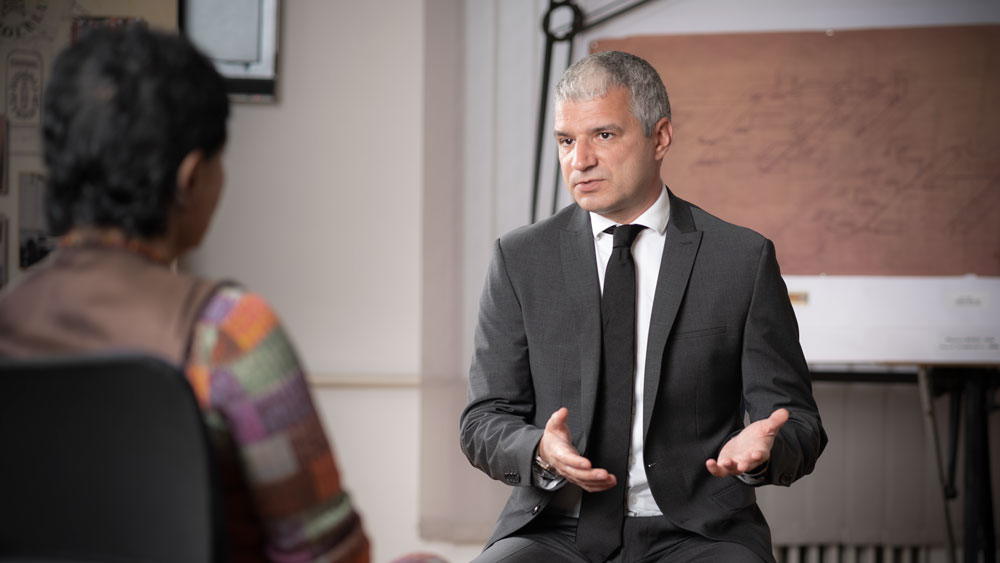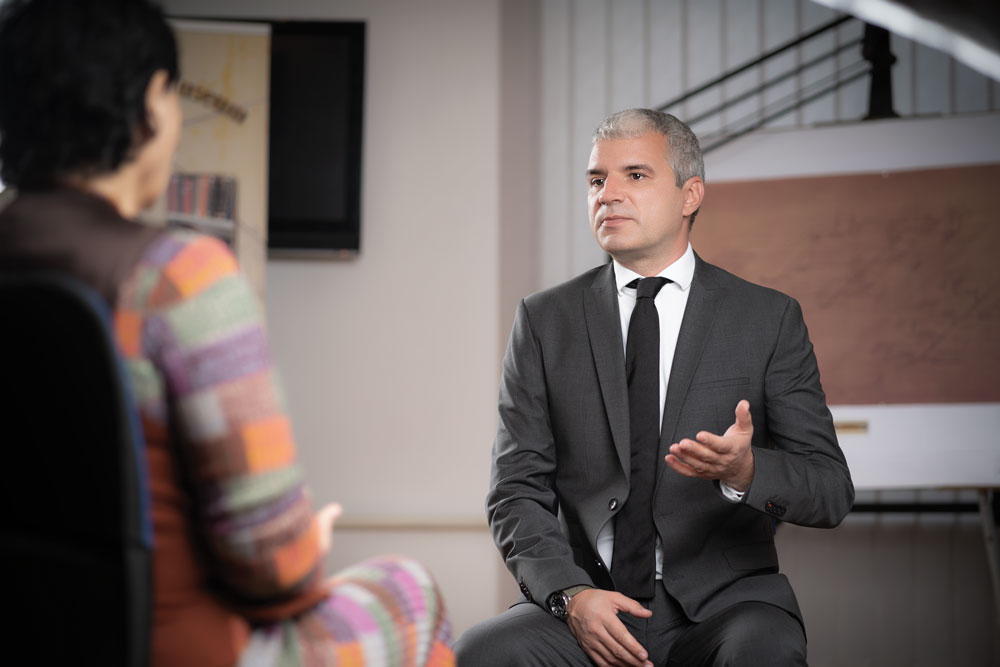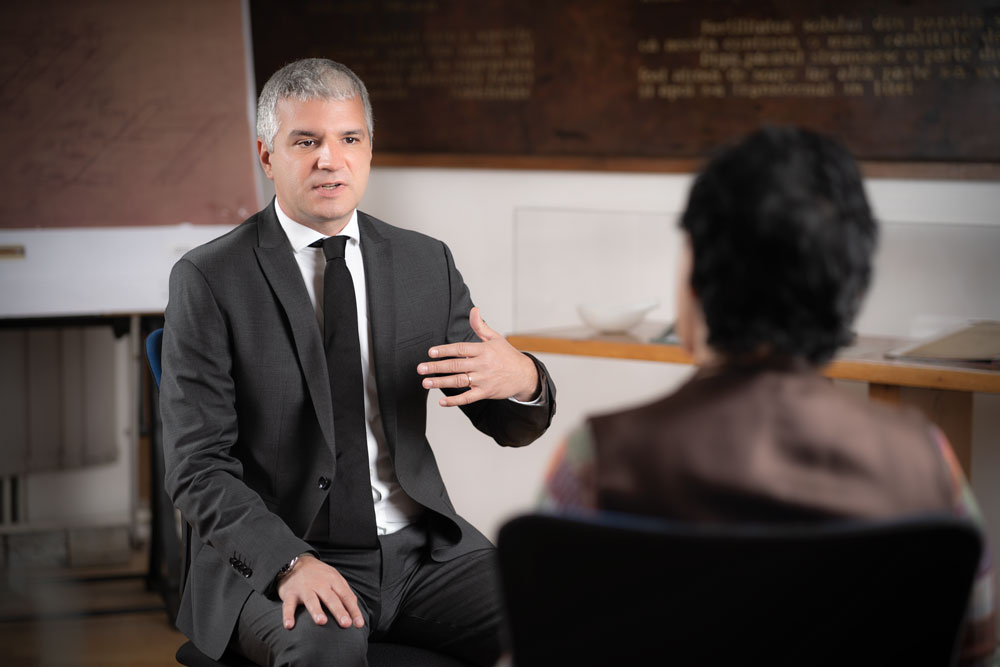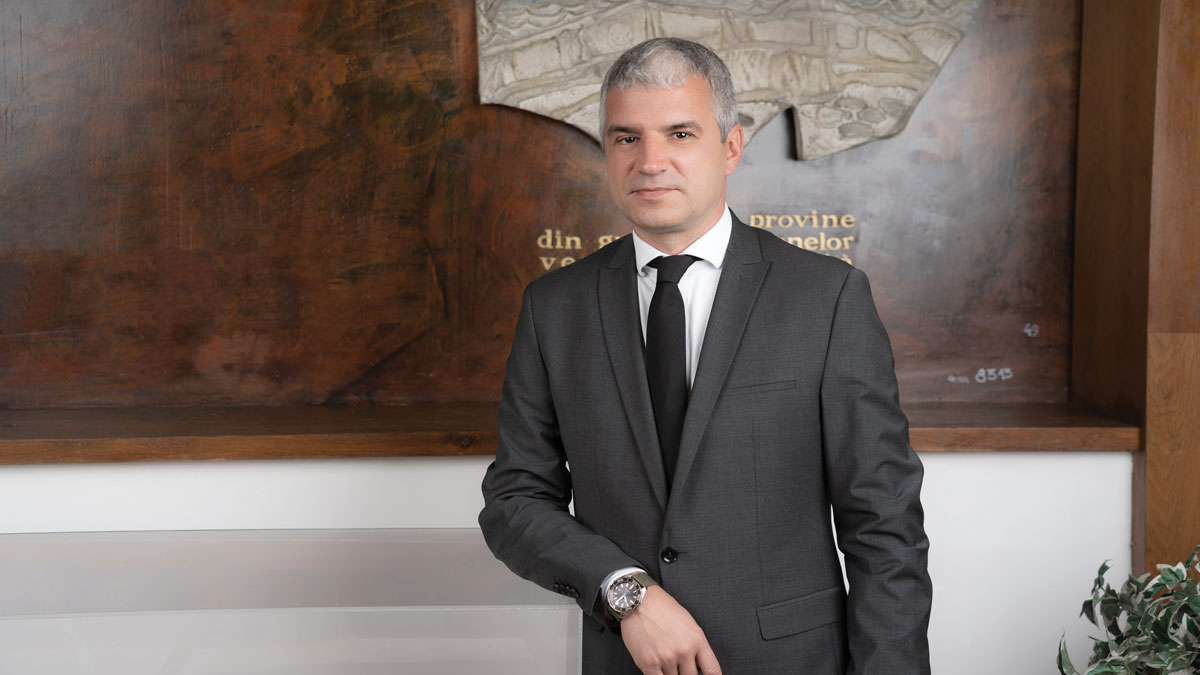Robert-Ernest Cruceru: Romania’s Contribution to EU’s Climate Neutrality and Energy Independence
We talked at length with Robert-Ernest Cruceru about REPowerEU goals, energy supply sources diversification, energy efficiency, decarbonization, and Romania’s contribution to EU’s climate neutrality and energy independence.
Robert-Ernest Cruceru is a lawyer specialized in the field of energy and infrastructure, with over 10 years of experience.
He graduated from the Faculty of International Economic Relations at ASE and from the Faculty of Law in Athens, as part of a scholarship program.
The representative projects in which he has provided assistance in recent years in the energy field include gas treatment stations (total capacity of 700mcm/year), gas metering stations, BRUA (gas pipeline execution), Baltic Pipeline Project.
Mr. Cruceru, REPowerEU is a response of the European Commission to the current geopolitical situation. In addition to phasing out its dependence on Russian fossil energies, it aims to accelerate Europe’s transition to renewable energies, to diversify supply sources, and to thereby improve Europe’s energy security and autonomy. In your viewpoint, as energy expert, how will Romania cope up with the possible problems in achieving REPowerEU goals?
Robert-Ernest Cruceru: RePowerEU represents an acceleration tool to the EU Fit-for-55 targets, aimed at reducing the dependence from Russian fossil fuels, especially natural gas. The initiative, in principle, is two folded. On one hand, the dependence from fossil fuels should decrease now faster with the aim of year 2027 for zero dependence from Russian natural gas, while on the other hand, EU seeks to diversify its gas suppliers.
With RePowerEU, the European Commission takes on a coordinated approach, in addition to Fit-for-55, by increasing or frontloading the efforts to advance energy efficiency gains, remove infrastructure tailbacks, increase the share of renewable sources, increase LNG and pipeline imports from reliable third parties’ partners and increase the levels of renewable hydrogen and bio-methane.
These accelerative measures involve an estimate additional investment of EUR 300bn by the end of 2030 out of which EUR 210bn is frontloaded until 2027. One criticality in these ambitious targets is to significantly increase renewable hydrogen and bio-methane deployment, which needs special attention both in securing production capabilities but, at the same time, securing the uptake on the demand side, especially in the hard to decarbonize industry and transport sectors.
To implement RePowerEU, investment is required in several areas, including scaling up the production of clean energy technology components and equipment in EU. Furthermore, as the green hydrogen is regarded as a critical element in the EU long-term plan, the installed capacity of electrolysers needs to be increased with 21 GW to 65 GW by 2030, while the wind and solar production capacities to sustain such added production need to increase with 41 GW to 510 GW for wind and with 62 GW to 592 GW for solar.
If RePowerEU implementation proves successful, the gas consumption in EU by 2030 will decrease by additionally 100 bcm from to the estimated 116 bcm included now in the Fit-for-55. In terms of percentages, the 116 bcm relates to 30% of EU natural gas consumption. The demand for natural gas could also shrink by additionally 40 bcm by 2030, should the high prices for gas and oil products stay long-term. This will provide incentives for both industrial and residential consumers to seek alternative energy sources.
To ensure a long-term transition to a carbon neutral economy, the investment into the electricity, hydrogen and natural gas infrastructure is another important aspect. If we consider the power grid alone, the additional investment needed is estimated at EUR 39 bn to cope with the estimated new capacities needs in the renewable sector. Likewise, the diversification of import sources will require under RePowerEU an additional EUR 10 bn of investment until year 2030 to ensure sufficient supply and constant distribution of natural gas across the EU Member States. Any new infrastructure should be designed with the aim of being resilient for future use in line with the carbon neutral economy and, at the same time, to avoid stranded assets. This can only be achieved by close cooperation between Member States, which should take advantage of local synergies.
The implementation of such ambitious plan is heavily reliant on fast deployment of fossil free technologies, which at their turn may be delayed or put at risk if the Member States do not work together to ensure clear and structural implementation where risk factors as financing, regulatory red tape or availability of skilled labour force are mitigated.
The stakes are therefore high for all the Member States and Romania must be part of such efforts, especially that it enjoys a good diversification of energy mix and may tap into a skilled and valuable labour force.
However, from the previous experiences, I am rather reserved about Romania’s capacity to implement large scale projects within the RePowerEU or Fit-for-55 plans. One of the main bottlenecks I see is the red tape associated with any new project developments in Romania. The permitting needed to establish a new electricity production facility, irrespective of its type, is rather confusing and not streamlined, as different interpretations are often given by the authorities.
This is mainly driven by the multitude of changes in the applicable laws, regulations and the like that occur. These are confusing many investors that cannot rely on a predictable legal framework going further and, eventually, translate to higher costs that will be passed in the end to the consumer.
With emphasis to the RePowerEU, Romania may benefit from approximately EUR 1.3 bn to increase its production facility, however, until this moment, there is no clear view from the authorities who will oversee the implementation of these projects and the criteria used for their selection.
To be able to benefit from its obvious advantages, Romania must undergo very quick a structural and coordinated reform at authorities’ level to ensure an even playfield for all parties involved in the energy market.
Moreover, although included as participant to the energy market, more emphasis should be given to the consumer as active participant to the energy market and make sure that it is part of the energy reforms. Failure to do so will alienate the consumer from the envisaged changes and will make the transition from the status quo difficult.

Governments throughout Europe are preparing for the winter energy squeeze. Romanian authorities act to support European aims and build energy independence, while also providing Romanian families with relief from the increased costs inflicted by the energy crisis. What measures must be taken to protect the vulnerable citizens?
Robert-Ernest Cruceru: The energy market indeed is under major pressure. It was affected initially by the covid pandemic and later by the Russian invasion of Ukraine. These factors acted as significant disruptive causes that in the end lead to extraordinary price increases.
Furthermore, it has shown a vulnerability at EU level, where the heavily reliance on extern energy supplies could not be replaced on short notice. Therefore, we are seeing now plans like the RePowerEU that its main purpose is to reduce the dependency from Russian natural gas with 2/3 by the end of this year and to zero by the end of 2027.
Unfortunately, we notice that all European countries have been affected by the increase in the energy prices, both industrial and residential sectors alike.
Although we see that several Member States already implemented measures to help coping with the energy price increases, I believe that the best way forward is that measures are taken collectively at EU level.
On short term, the Member States should secure stable and diversified alternative sources. This can be done through the existing pipelines and LNG terminals. There are several pipeline projects and extension of LNG terminals that are to be commissioned this year. For our region the Greece – Bulgaria pipeline that ensures the diversification of gas sources from Azerbaijan is of particular interest, as it may also be connected to the Romanian project BRUA.
Equally important for the EU diversification, is the Baltic Pipeline that will be commissioned this year and will enable gas flow to Poland and the general Central and Eastern Europe.
Apart from the alternative sources of import, similarly important on short term are the behavioural measures that can be implemented by each of us. As mentioned before, the consumers, if acting together, could be the main force of change on short and long term. On short term, energy savings or efficiency measures could lower the demand for crude oil by 850,000 barrels per day within the EU Member States.
Also on short term, Member States should provide immediate relief to the affected families in EU. It is discussed at the level of European Commission to cap the energy prices within EU. This could prove a good solution on short term; however, any such intervention must be done in a very coordinated manner and to a level that will also ensure that the energy supply is still maintained at proper levels and avoid shortages.
Romania has also tried several schemes to defer the energy price increase to the consumers, which suffered changes since its establishment. In principle, the Romanian state would cover the price increase over a certain price threshold directly to the electricity suppliers. However, the scheme created major difficulties for the suppliers because they did not receive the price difference on time.
Since the results of the compensation schemes were not as envisaged, the Romanian state is now undergoing an analysis to temporarily return to a regulated energy market. Although is early to speculate on the impact such measure will have on the Romanian energy market, a general regulated energy market should be avoided, as this would most likely bring a halt to the investment in new production capacities, refurbishment of the infrastructure or even will put producers and suppliers, especially the small ones, in great difficulties.
I believe that any measure to be implemented in Romania to assist the vulnerable families should concentrate in identifying such and provide focused support for the affected families. The energy market should be encouraged to increase competitiveness and the consumers should have the tools to easily choose between the offers that are more competitive. Incentives offered to consumers to increase their energy efficiency should also be put in place to encourage them to take advantage of the available technologies.
There are several political and economic reasons to cooperate with neighbouring countries and benefit from existing and future electricity interconnectors. How important is it for Romania to be competitive on the European energy market?
Robert-Ernest Cruceru: Romania is very well placed in terms of its energy mix and possibility to develop new production facilities. However, the window of opportunity is rapidly closing, and fast actions must be taken.
If we look at the gas resources in the Black Sea, their exploitation was blocked several years due to Romanian’s state failure to put in place a clear and balanced legal framework. The result is that Romania may not benefit during this crisis from an asset which would have made Romania an important strategic player within the EU. We can say that this was for certain a lost opportunity.
The same we can say about the renewable sector. After 2010, Romania has seen a lot of interest from the investors, mainly driven by the green certificates support scheme. After significant production capacities have been installed, other being in the development phase, the Romanian authorities have made subsequent changes that put-on halt the development of new production capacities. The changes went that far that the producers were not even able to trade all their green certificates upon their release. In general, the renewable market was not affected that much by the general economic situation of the projects but by the lack of predictability of the legal framework. Romania was pleased to achieve the minimum EU targets for renewable capacities and never interested to look beyond. This was also a lost opportunity at that time.
With Fit-for-55 and the newly RePowerEU plans, Romania has another big opportunity to establish itself as a major player in Europe in what regards the energy market. Romania has good conditions for energy production facilities from renewable sources but also should look ahead in developing green hydrogen production facilities and biogas. For all these developments to occur, we should look to the past and learn from those experiences.
The energy market in Europe is highly competitive and we see that all Member States are interested in developing major projects in collaboration. Only this year, Germany, Denmark, Belgium, and Netherlands signed a EUR 135 bn pact to develop 150 GW of wind farm in the North Sea by 2050 with envisaged 65 GW by 2030. This will allow these countries to become a major player in the energy marked and tap into the green hydrogen opportunities.
To be able to compete in this market, Romania must set its energy strategy fast, with clear targets, taking due consideration of its advantages and achievable targets, while considering preservation of its environment. These must be then followed consistently, with clear regulations and predictable legal framework.

Romania is committed to fighting climate change and pursuing low carbon development. How can Romania contribute to EU’s climate neutrality and energy independence?
Robert-Ernest Cruceru: The Black Sea has a great potential for generating wind power, around 72,000MW according to Word Bank.
Beside the onshore and offshore potential in Romania, according to the National Energy and Climate Plan, Romania aims to install around 2 GW of wind and 3.5 GW of solar.
With hydropower representing around 30% of national electricity generation mix, Romania could refurbish such capacities for a long-term use. However, their environmental impact and potential conflict with other competing intensive water technologies – hydrolysers, could bring changes.
The EU voted to keep some specific uses of natural gas and nuclear energy in its taxonomy of sustainable sources of energy. However, while the EU did vote to keep nuclear and natural gas in its green taxonomy, it did not give those sources of energy a free pass to be included in every situation. In Romania, the nuclear power still seems to be in the centre of attention, although the viability of future developments of Units 3 and 4 is hard to foresee.
The construction of small modular nuclear reactors in Romania is also on the agenda. Although some of the European countries are interested to decommission their nuclear plants, Romania seems to still bet on this source.
Romanian authorities will have to work very hard to ensure that RePowerEU minim targets are achieved. We are talking of entire energy ecosystems, from sources diversification, production facilities, storage, transport infrastructure and implementation of hydrogen in hard-to-abate sectors. All these efforts must be well prepared and be based on predictable and easy to follow legal framework. I believe that the time frame is very short, especially with the frontloaded actions in the RePowerEU.
Romania may prove to be a pillar in the EU’s climate neutrality and energy independence, but it needs to work towards achieving its potential. I believe that the targets included in the National Energy and Climate Plane should be more ambitious for a county like Romania. For comparison, we see other Member States which do not benefit from our natural conditions that are in the upfront of implementation and project proposals for financing. We can observe that the same countries also lead the way in R&D or new technologies implementation (e.g., production of clean energy technology components).
Energy is always a hot topic, as well as the climate change, price of oil, environmental protection, the health of the economy. How do you assess Romania’s real potential for infrastructure reconversion to accommodate the energies of the future?
Robert-Ernest Cruceru: The EU funds will be the key for the energy infrastructure development and reconversion in Romania. There is no doubt to my mind that without these funds there is no chance to keep up with the rest of the Member States.
But Romania is not alone in this effort and should not act in an insular manner. The need for additional energy infrastructure should be assessed at EU level, with special emphasis to regional specificities. When considering that the natural gas consumption is set to decrease in the future, synergies between the gas and hydrogen infrastructure investments must be considered to avoid stranded assets and, therefore, buried investments.
Note should be made that the European Commission still maintains its position that blending hydrogen into the natural gas systems needs detailed consideration as it decreases the gas quality and increases the cost to adapt for the end users. Most probably, the costs for end consumers to adapt will be higher than just switching to electrification.
Likewise, the development of hydrogen infrastructure should be closely linked to the development of production facilities from renewable sources. Hence, location of electrolysers for hydrogen production, storage and transportation must be considered. Repurposing of regasification facilities to receive ammonia could be also an option, as the latter is a good alternative to liquefied hydrogen.
With the frontloaded increase of the renewable production capabilities under the RePowerEU, the electrical grid must also adapt to the accelerated implementation. The additional reinforcement efforts under RePowerEU amount to EUR 29 bn over the decade with additional EUR 10 bn for storage.
Romania, through RePowerEU must ensure that all investments and reforms fit the national context and ensure an efficient implementation of the objectives.

The energy transition is a pathway toward transformation of the global energy sector from fossil-based to zero-carbon by the second half of this century. What transition energy sources do you consider more suitable for Romania and not only?
Robert-Ernest Cruceru: With the energy transition we change our habits of producing energy from sources that are intensive in the release of greenhouse gases – such as fossil fuels, to those sources that release little to none.
With the Paris Agreement, 180 countries have set the direction to follow to do the switch, with the aim to limit the increase in global average temperatures to below 2°C relative to pre-industrial levels.
Considering that most of the world’s electricity is produced from burning fossil fuels, reaching these goals will require that minimum 80% of the electricity production is shifted to low carbon emitting sources.
A switch of this magnitude is not possible overnight, therefore the discussion was always what would be the preferred transition energy source, one that could release less greenhouse gases, but at the same time being reliable and efficient in energy production.
Natural gas emits almost 50% less CO2 than the coal. It is the cleanest out of all the fossil fuels for energy production. Moreover, it is rather easily to transport, distribute, store and it is efficient.
Therefore, natural gas is currently being considered as a transition/temporary fuel while more sustainable technologies mature. Without a transition fuel or supporting technology, the transition into zero-carbon emission may not materialize.
However, continuous investments in natural gas without considering synergies with the green hydrogen could hinder or delay the sustainability transition rather than help it and will result in stranded assets.
Private investment is essential for ensuring economic growth, sustainable development, and poverty reduction. In times of crisis, as we all know, the investors look for predictability and stability. Does Romania’s legislative framework encourage the investors? What should be the best approach to date for improving investment conditions in Romania?
Robert-Ernest Cruceru: Investments, in general, irrespective of whether are private or public, ensure economic growth and advancement if properly managed.
But the private investments are more sensitive to extraneous factors. The decision to invest or not in a certain country takes into consideration many factors, the predictability of the legal regime being on top of the check list.
The legal framework in Romania, unfortunately, is lacking predictability. We are seeing constant changes of the legislation, most of the times though government emergency ordinances, which later are at their turn modified by their enactment laws.
If we look at the Energy Law 123/2012, this enactment alone was modified around 34 times since 2012. When considering the secondary and tertiary enactments affected by these modifications, we can get an idea of the lack of predictability. The situation is the same if we look at Law 220/2008 regarding the green certificates support scheme, which sustained around 20 modifications with downstream effects to dependent enactments.
This type of behaviour from the authorities affects the trust of the investors which see Romania as a country with high regulatory risk. Romania needs investments in all sectors, not only in the energy sector. Therefore, the regulatory burden should be removed, processes simplified and, as much as possible, the different applications should be done exclusively online by removing human interaction.
Another deterrent factor for the investors is represented by the judicial system, which is overloaded and does not offer quick resolutions to various disputes that might arise between partners. A minimum term for a dispute resolution is 1-2 years, even more so if we deal with complex projects as the investors in the energy sector do. Therefore, quick resolution mechanisms would be beneficial for the investors to be certain that in case of disputes effective measures may be taken to protect their investments.
More and more contractors in the energy sector warn on the increasing difficulty of contractual terms and major contractual risks. What would be the solutions to these issues and the effective measures to preserve the contractual equilibrium?
Robert-Ernest Cruceru: This is a very ardent topic I would say. More and more contractors are affected by the terms and conditions of the draft contracts used for the major projects, but also by the interpretation given by the contracting authorities to the respective conditions.
When perusing the contract conditions, one may easily observe that such contracts are not drafted in the sense of correct, good-faith and transparent collaboration. Most of the obligations are on the contractor’s side, while the little rights and entitlements the contractor has under the contract are limited to strict notification periods or provision of supporting particulars in a specific way. Failure to do so triggers the contractor’s impossibility to ask for its entitlement.
The result of these abusive provisions is that contractors are faced with losses while the contracting authorities benefit from work performed by the contractor – on its cost, without the possibility to claim them back.
Equally concerning is the contracting authorities’ behaviour towards the contractors during the execution of the project. Even under the circumstances that the contractor complies with the notification periods and provision of supporting particulars, their claims are usually rejected or protracted for various reasons. When considering that a potential subsequent claim in court will last more than 1-2 years, in a good scenario, the contractors have in fact no possibility to ensure a short binding decision.
As a manner to mitigate the risks it is highly advisable that the contractors appoint dedicated personnel to gather relevant information on daily basis from the site and send it to the project manager. Moreover, the information kept in the daily site records must be detailed enough to describe any event that could lead to entitlements.
However, to ensure the success of the projects, the contractor’s efforts to keep good records is not enough. In the end, when signing a project, both the client and the contractor enter a collaboration where they expect to obtain a gain.
Hence, the collaboration should be always in good faith and transparent. The contracting authorities should firstly take more time to prepare the tender packages thoroughly, with potential risks or occurrences to be already included in the contract and automatic mechanisms to be immediately applied. Secondly, when faced with the occurrence, to act fast and correct towards the contractor.
In the end, the priority should be on the successful finalization of the project and not a stance where the contractor’s claims are rejected at any costs.
What is the biggest challenge you have faced during your work in the energy field?
Robert-Ernest Cruceru: Any project has its specifics and different related challenges. But most of the times, together with the clients, we find solutions to move forward.
I usually travel to the project sites and work closely with our clients as part of the team. Looking back, I would say that working during the pandemic was a tough one for everyone, especially on site. But we managed to organise our work safely, which is not that difficult when you have good and professional people around you.
The use of renewable energy sources is predicted to increase in the global energy supply over the next decades, whilst the utilization of most non-renewable sources is expected to decrease. What top energy sources in 50 years do you see?
Robert-Ernest Cruceru: In the context of RePowerEU acceleration measures and Fit-for-55, I believe that renewable sources will lead the way. I refer here mainly to wind and solar power. The aggregated estimated installed capacities by 2030 in these technologies is estimated at 1,102 GW. The overall energy from renewable sources target is set at a minimum binding 45%, while in the electricity sector its share would reach 69%.
Of all sectors, transport has, in 2020, the lowest penetration of renewables with a share of 10%. By 2030, this needs to increase to reach 32%.
Between 2020 and 2030, the share of wind and solar energy in installed power production capacities is projected to increase from 33% to 67%. In 2030, solar energy would also be the largest electricity source in terms of capacity, with more than half expected to be solar-rooftop capacities. Wind energy would have a 31% share of installed capacity in 2030, with an increase of 12% from 2020.
Hydrogen will also play a vital role in the energy sources of the future. With the RePowerEU, the implementation of green hydrogen is accelerated, increasing the target from the Renewable Energy Directive of 5.6 Mt by 2030 to 20 Mt. The biggest increase comes from the intended accelerated implementation to refineries, industrial heat, transport, petrochemicals, and ammonia/derivatives/imports.
A rapid development of energy infrastructure that connects supply and demand is a key ingredient for the envisaged acceleration of hydrogen production and use in the EU and beyond. This concerns transport via pipelines, as well as through adapted LNG terminals, and storage. The development of port infrastructure and their connection to both industrial and transport users will be very important.
The envisaged upscaling of the hydrogen infrastructure will rely mainly on repurposed pipelines to which new build ones will be added. A coordinated effort will have to be conducted by Member States to assess which pipelines may be repurposed and which will need new developments.
The European Commission estimation for investment amounts to EUR 75 bn for electrolysers, EUR 38 bn for EU internal pipelines and EUR 11 bn for storage.
An important role in the long-term strategy to achieve independence is the increase of biogas production and its subsequent conversion to bio-methane. The target is to achieve production of 35bcm of bio-methane by 2030.
We appreciate the hospitality of the National Oil Museum in Ploiesti, thank you for hosting the photo session.







